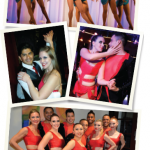
Dr. and Mrs. Miller dance the foxtrot at the October 2015 Chicago qualifier competition for the USA Dance National Championship.
Slow, slow, quick, quick.
Don Miller, PharmD, has repeated that phrase to himself countless times over the past 40 years. Since the 1980s, Dr. Miller, a professor of pharmacy practice in the College of Health Professions at North Dakota State University (NDSU), has been a competitive ballroom dancer.
Repeating that phrase is common to all ballroom dancers, along with counting steps and avoiding the cardinal sin of stepping on their partner’s toes. This may sound fairly complicated, but Dr. Miller, who was lured to the dance sport as a means for socializing and exercise, says he’ll dance as long as his legs will carry him.
Dr. Miller’s journey from the classroom to the ballroom began in 1976, after he received his Bachelor of Science in Pharmaceutical Science from the University of Manitoba in Winnipeg, Canada. Two years later, he received a Doctor of Pharmacy degree at the University of Michigan and then completed a one-year pharmacy residency at the University of Saskatchewan Hospital in Saskatoon, Saskatchewan, Canada. Then, in 1979, he accepted a teaching position at NDSU.
He became attracted to the field of rheumatology in the 1980s, when he worked closely with a rheumatologist, Justus Fiechtner, MD, on a number of drug studies, some sponsored by pharmaceuticals. Throughout his career, he also held other titles, such as an editorial board member for Arthritis Today, published by the Arthritis Foundation, and previously as a member of the ACR’s Drug Safety Subcommittee and Rheumatologic Care Committee, and now serves on the Food and Drug Administration’s Arthritis Advisory Committee.
Shortly after moving to Fargo, N.D., for his teaching position, he began searching for creative ways to meet people and “get out of the house,” says Dr. Miller.
“I had never done any dancing, had no musical ability,” he says. “I was pretty bad when I started.”
But he really enjoyed it, so he stuck with it. He says it took approximately a year of weekly dance lessons at a local dance studio before he could both hear and feel the beat of the music.
Competition Circuit

Dr. and Mrs. Miller dance the waltz at the February 2015 New York Dance Festival.
Dr. Miller made much progress during those early years, entering his first Pro/Am (professional/amateur) newcomer competition with his teacher in 1983. They performed several American Smooth dances, such as the tango, waltz, foxtrot and Viennese waltz, along with American Rhythm dances, which included the cha-cha, swing, bolero and mambo.
Typically, he explains that all dancers wear suede-bottom shoes so they can easily turn and grip the floor at the same time. Only those competing at higher levels wear fancy costumes. Just as well. If purchased new, he says, men’s attire generally runs under $1,000, and women’s gowns can cost $3,000 each off the rack.
During his first competition, Dr. Miller wasn’t focused on anyone’s clothing.
“I was nervous, especially as the man, being the leader,” he recalls. “You’re trying to lead your partner, trying to remember your steps, trying to listen to the music, all at the same time. There’s a lady in your arms, so you don’t want to look too silly.”
In the early days, he says he took home many trophies from competitions, because sometimes, he and his dance teacher were the only couple on the dance floor in their category.
“In those days, I probably collected 50 trophies in the newcomer and bronze divisions,” he says, explaining that there are four amateur categories of competition—newcomer, bronze, silver and gold.
As the years passed, he was ready for bigger challenges and enrolled in dance lessons at the Arthur Murray Dance Studio in Minneapolis, a mere 240-mile drive from Fargo. He spent many weekends in the city, receiving several hours of both group and individual dance lessons every month.
Then in 1991, he met Joan, his future wife, now a chief master sergeant (ret.) in the Air National Guard. “She fell in love with me and ballroom dancing,” he says. Joan soon became his partner and joined him in taking dance lessons as a couple at independent dance studios in Minneapolis.
After they were married in 1992, the pair competed together during the next five years, entering amateur competitions in the American Smooth division. He prefers this style of dancing, he says, because there are fewer restrictions than the International Smooth category, in which couples have to remain in body contact at all times.
Better Teacher, Better Marriage

Dr. and Mrs. Miller dance a waltz at the January 2016 Snow Ball in Minneapolis.
From 1997 to 2014, the couple took a hiatus from competitions—but not social dancing—due to grueling work and personal schedules. Recently, they began teaching a social dance class, coaching college students at NDSU, and returned to competition last year.
“We’ve got to be on the cutting edge of our own dancing if we’re going to be credible with our students,” Dr. Miller says, adding that he and his wife will be competing in the national amateur championships in Baltimore this April.
Meanwhile, Dr. Miller says ballroom dancing has helped him become a better teacher by reminding him how hard it is to learn a new skill. Whether that skill involves medicine, pharmacy or dancing, he says he realizes how much practice all new skills require, especially for students in a clinical environment.
Now 61 years old, Dr. Miller says his 24-year marriage has also benefitted from dance sport. Besides keeping Joan and him active and healthy, he believes it has strengthened their emotional bond over the years.
“As people get older and get busy, sometimes you drift apart,” he says. “This is one activity that has always brought us together in a positive way.”
Carol Patton is a freelance writer based in Las Vegas.


